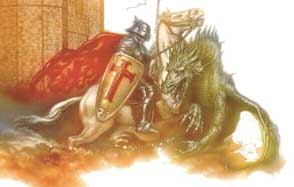The peaceful little town of Mont Blanc was a contented place. It was governed by a good wise king and had a healthy economy. The King had a very beautiful daughter who was loved and respected by all. The only cloud on the horizon was that the inhabitants of the town were not sufficiently pious and they often forgot to offer up gifts to the gods, which considerably angered the pagan priests. Legend has it that one midsummer's day an enormous dragon with brilliant greeny-blue scales rose out of the river. The horrendous beast appeared before the terrorized population and spoke to them thus: 'Every month you must bring me a beautiful young virgin for my food,' he crooned in a sing-song voice, 'otherwise I will destroy your homes and your fields, your crops and all your livestock. If you obey me, I promise I will not attack anybody and I will allow you to live in peace.' The terrified townsfolk ran to the palace to tell the King of their misfortune. Much to his sorrow, he had to accept the dragon's conditions. In vain the population entreated the gods to liberate them from the terrible monster, and in vain the priests of the pagan cults offered up sacrifices and gifts to the gods begging them to rid the town of the menace. Months went by, and every new moon a young virgin was handed over to the starving dragon. The situation became unbearable. In the homes where they were not weeping over a dead daughter, they feared for the fate of their childre, and girls were flinging themselves into the arms of the first man they met so they would no longer be virgins. Girls designated as future victims had to be locked up and heavily guarded to prevent them from killing themselves to avoid their terrible fate.
Resigned to her misfortune, the girl, who not long before had converted to Christianity, spent the night in prayer, an in the morning, attired in a white tunic and crowned with flowers, she bade farewell to her grief-stricken parents and the weeping villagers. With a strength of mind inspired by her faith, and trusting completely in the Virgin Mary, the girl made her way alone to the dragon's cave and calmly awaited her end, praying all the while. The legend describes how the townsfolk gathered along the city walls to wait for the monster to come out of his cave, and to witness the imminent tragedy. Suddenly an unknown knight arrived, galloping furiously on a white charger with a silver mane. It is said that his weapons shone like silver and his cloak was as red as glowing embers. His shield was emblazoned with a red cross on a gold background. Without dismounting or reining in his horse, the stranger charged at the beast. Overwhelmed by the power of the magnificent horseman, the dragon retreated and tamely lay down. 'My lady,' said the stranger, 'tie the belt from your tunic around the dragon's neck and he will follow us meekly.' The girl fearlessly carried out his instructions, and the animal allowed himself to be led away without offering any resistance. The strange procession made its way to the gates of the town, where the inhabitants were waiting in astonishment. The girl ran to embrace her parents, while the pagan priests boasted that they had defeated the monster with their offerings and rituals. The knight asked for silence and the whole town listened to the words of the mysterious and valiant savor. 'I am George, the soldier of Christ,' he said, 'and I am devoted to Him. This young Christian girl prayed for help from Mary and her son, the Redeemer, and that is why I was given the mission of saving her from death. May the cross which saved you crown this town forever. Abandon your false idols and you need never fear the dragon again.' And to confirm his words, the young knight traced the sign of the cross above the docile monster. Immediately, the animal was transformed into a rosebush with roses as red as blood. Still today, in Catalonia, the name of Saint George is associated with red roses, as a reminder of the knight who rid them of the terrible dragon forever. |
 After a while, there were no virgins left, and the only people who were pleased were the
pagan priests, because the people were returning to religion and making offerings to the gods. The month of April came, almost a year
since the arrival of the monster. Fate's next victim was the King's daughter, who had insisted on taking part in the lottery of young girls
destined to be
sacrificed.
After a while, there were no virgins left, and the only people who were pleased were the
pagan priests, because the people were returning to religion and making offerings to the gods. The month of April came, almost a year
since the arrival of the monster. Fate's next victim was the King's daughter, who had insisted on taking part in the lottery of young girls
destined to be
sacrificed.